
Alnwick Farmers’ Market Friday 30th August 2013
Alnwick Farmers’ Market
Friday 30th August 2013
I have really enjoyed reading other TFL regulars posting about their baking adventures in relation to their local farmers’ markets. I attended my own local market on Friday of last week and thought I’d do a short blog post with some photographs of the products I offer for sale. I’ve posted formulae for most of these more than once before, but it may be instructive for me to give more description for each of them here, as they are currently made.
Here are some photographs taken at the market to give a flavour of the Bread and Roses' range:
All these breads are now made using only natural leavens.
The Moscow Rye is unchanged; 100% rye sourdough, 3-stage process. It is an 18 hour first fermentation, followed by the addition of a scald to the sour to create a sponge. 4 hours more fermentation before making the final paste. 1-2 hour bulk and 1-2 hour final proof, then bake. They go into the wood-fired oven at whatever temperature the oven is at; with lids on the pans. A hot oven sees an 800g loaf bake in just over an hour. But I have baked them for a LOT longer on the dead oven.
The Gilchesters’ Miche is unchanged too, but I find a 2 hour autolyse combined with a stiff levain gives the best results for a dough with 73% hydration using very weak locally grown organic and high extraction flour.
Seeded Sourdough has a long history, as we baked a Special Seed Bread at the Red Herring many years ago using Pumpkin, Sesame and Sunflower Seeds. The soaker of Golden Linseed is from Jeffrey Hamelman. The stiff white levain is my own, as is the choice of 50:50 white flour to wholemeal. Similarly with the Five Grain Levain which is very much based on the Hamelman formula, but using my stiff levain.
The Spelt bread is still a work in progress. I like that it allows me to use more local flour from Gilchesters. I like that there is interest in this ancient grain. My formula uses stiff levain of strong organic white flour at 30% pre-fermented flour, 60% hydration, with wholemeal organic spelt making up the remaining 70% of the flour. I don’t like: it’s bitter!! I use a raisin purée to try to offset the bitterness [with mere occasional success]. The crumb is tight and the dough dries out too quickly; an increase to 71% overall hydration has helped a little…but results in even less dough tolerance, as the fermentation always races like a train. I definitely do not like the cost either! Ok, it’s “a pig” to mill, and the yield is a mere two thirds of what you can expect from wheat; but how do I justify £23 for 15 kg as against £12 for 15kg of the lovely Farmhouse flour? I should explain that the regular wheat used by Gilchesters is a single variety “rare breed” Sativa wheat, organically grown, sourced specially from Germany on account of no fancy biologist arsing about with its genetic make-up over the last umpteen years and more. Try as I might I often fail to convince those who worship as the alter of Spelt that the Farmhouse flour offers equal provenance, is just as safe a dietary bet for those with issues, and, actually tastes a lot better. So I’m stuck trying to make a better spelt loaf. This one is not bad, but you can see I’m not raving about it; and that is not good enough. I want to love all the bread I offer for sale.
Moving on; the white bread. I’ve changed tack here; this is a more ordinary white bread. I like it much better too. Nigel makes a much better white loaf than I have ever achieved using the Gilchesters’ Ciabatta flour and a liquid leaven. A lot of this is to do with his oven, I believe. Anyway I was really happy with the 800g offerings I came up with this time. In summary, I now use only the Marriage’s Organic Strong White flour. I use stiff levain, 60% hydration, with 25% pre-fermented flour. I autolyse the remaining 75% of the flour for 1-2 hours. The overall formula gives 68% hydration. Nigel uses an overnight fermentation for his white dough. That doesn’t work for me. 2 – 3 hours of bulk fermentation with a couple of folds, followed by 1.5 – 2 hours final ferment gives me the best results. Of course, the real difference is in the leaven preparation, and I remain in favour of well-fed stiff dough rather than liquid levain. Feedback from colleagues is favourable and positive. This is good, as I find it very hard to get REALLY enthusiastic about any white bread.
The Toasted Brazil Nut and Prune Breads are now made with levain only. Originally, I used an overnight Biga. I make these as 400g loaves, in order to make them a commercial proposition. And, they are really popular at the Alnwick Market; I sold a dozen of them, even at £2.80 each. Why do nuts have to cost £10/kg here in the UK these days???
The laminated paste does use baker’s yeast, as a “straight” dough. I use an overnight cold fermentation. Once the butter is incorporated, I give four half turns to laminate the dough. Typically, this would involve 2 half turns, one hour rest, 2 more half turns, then a further one hour rest. I used 1kg of flour in the formula, and 420g butter. Yield gave me 15 Croissants, 10 Pain Amandes and 10 Pain au Chocolats.
Autumn at Bread and Roses looks busy; very busy indeed.
Happy Baking to you all
Andy
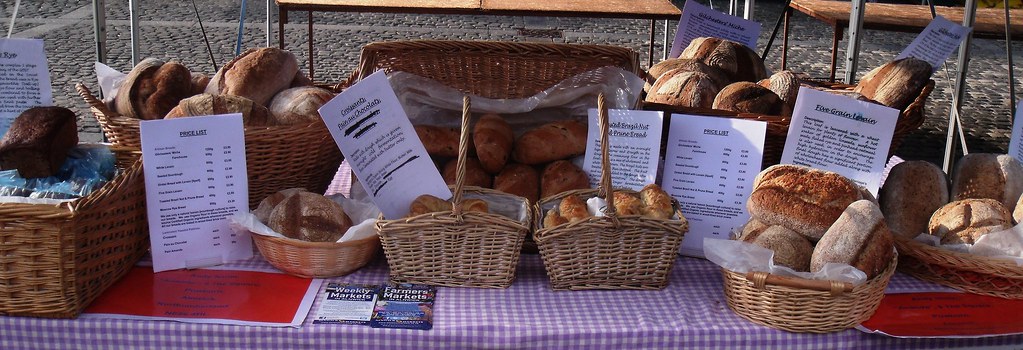
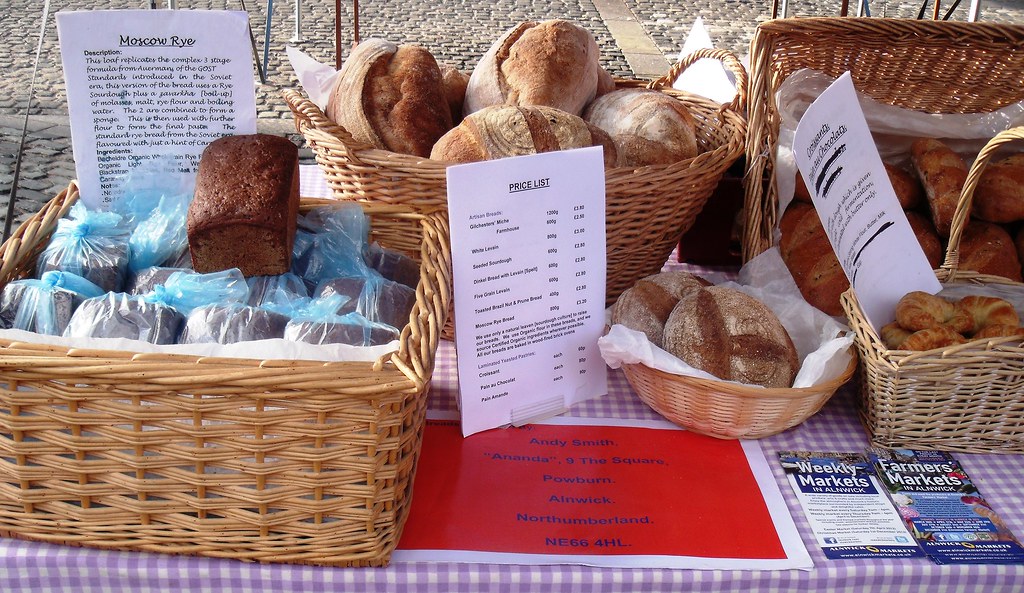
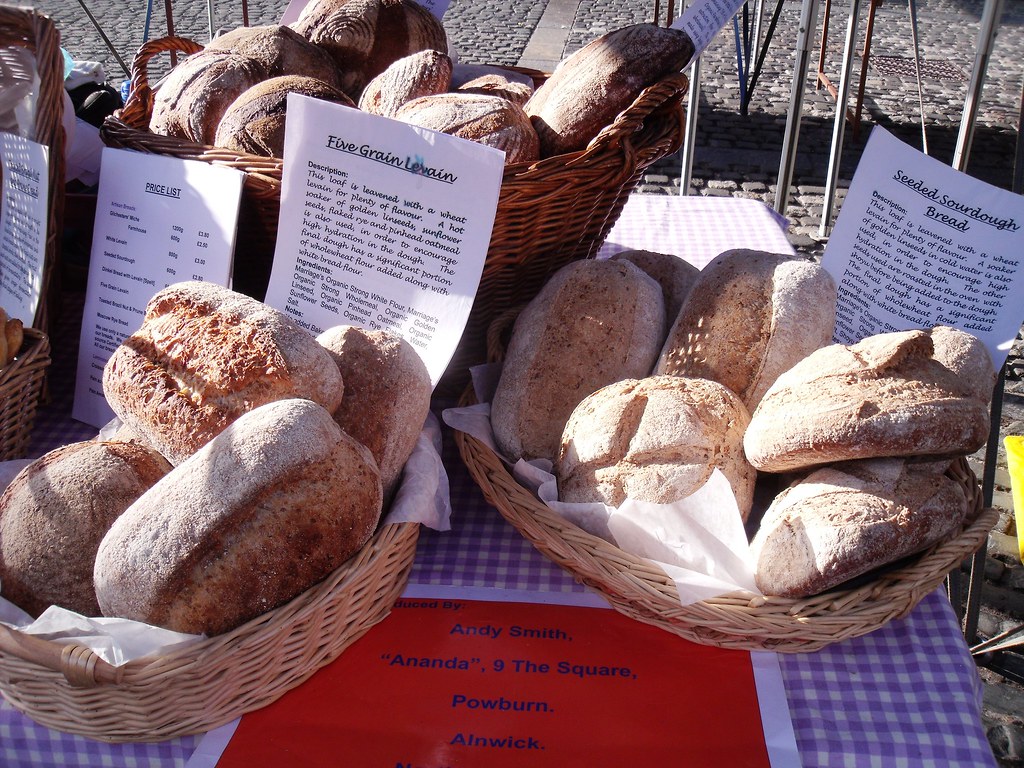
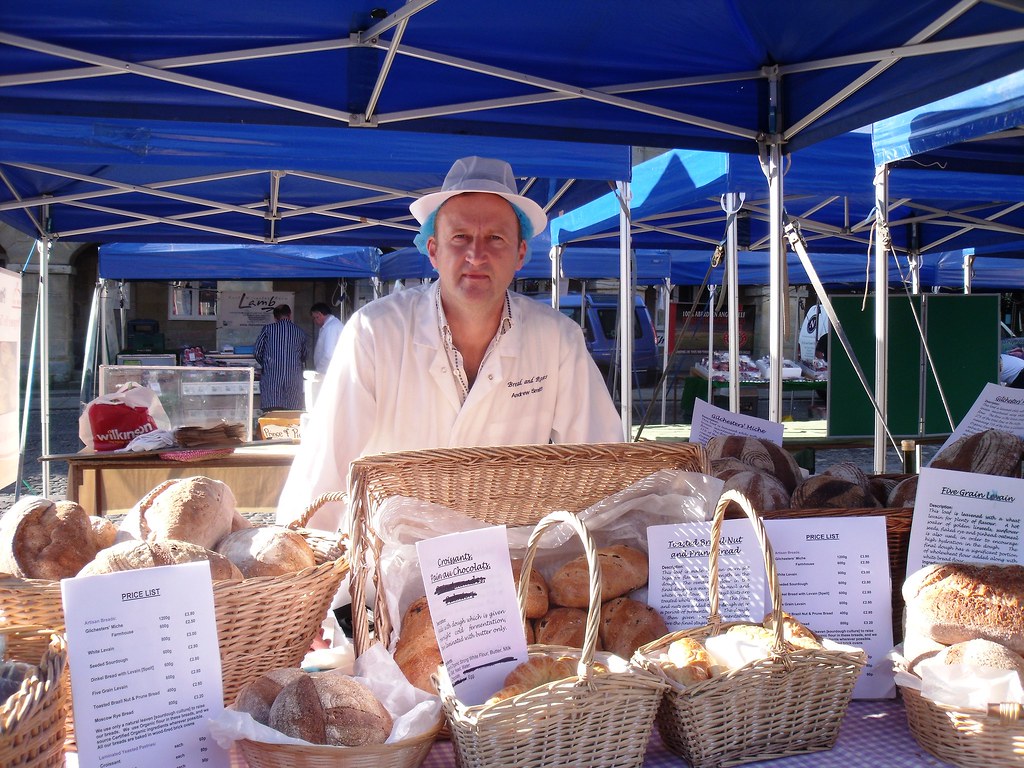
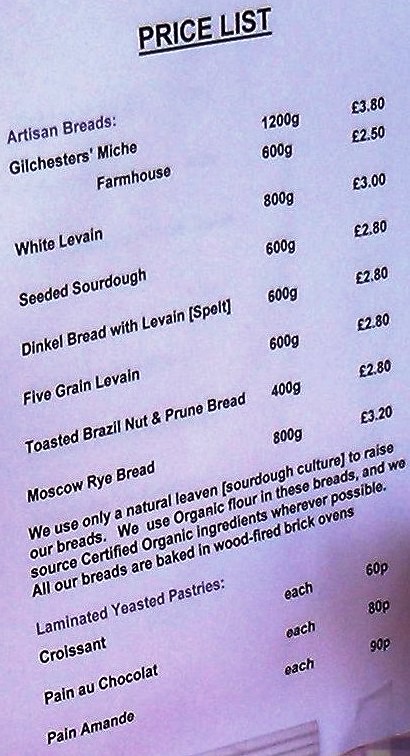
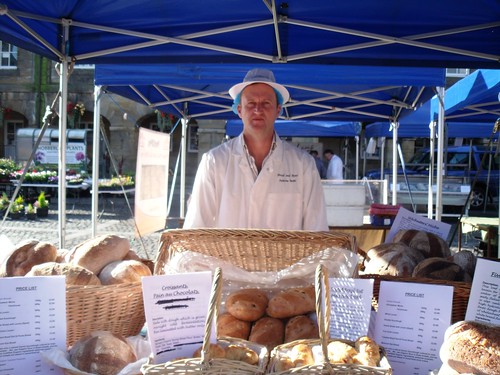


Comments
what a gorgeous display. Love your descriptions of your process and ingredients too ! You are one hardworking baker . The proof is in the pictures I bet the taste is outstanding. c
Thank you Caroline,
Process control and ingredient quality are the keys to fine bread manufacture for the artisan baker. I've always believed that is where the taste comes, Hard work is just a fact of life of course; but one to celebrate. It enables other pleasures which are essential to a full and enjoyable time.
Very best wishes
Andy
at that price Andy. Bet it flies off the shelf!
On sale I am paying $5.99 a pound for Brazil nuts at Sprouts for your prune and Brazil Nut Bread and we are closer to Brazil than you are :-) The prunes are only $2.99 a pound on sale but that is no great shake either. It seems the price of all nuts doubled about 2 years ago here for some unexplained reason and never came back down. It is still one of our favorites anyway and we bake it in $10 size. I suppose Lucy could put $10 worth of double chocolate stout in it for the liquid and make a $20 loaf of bread out of it - ridiculous!.
Glad you baking business goes well, you bread looks great and
Happy baking right back at you.
I'll steal that from DMSynder!
Fruit and nut prices seem similar in the US and UK then DA. But it's been that way here for more like 5 years, since the food price spikes of 2007-8. Food prices will only go one way of course; better get used to that one.
So, the miche is made from flour, water, salt. It's a hit; in any number of ways!
Your positive comments are very much appreciated
Best wishes
Andy
and display. The breads look lovely in their baskets with the old cobblestone road in the background. Lovely farmer's market bread booth.
Thanks for sharing, Andy.
Sylvia
Hi Sylvia,
Alnwick is a really beautiful old town, and the cobbles you can see cover the Market Square where all the different markets take place. It remains a struggling town; just like most places in the UK. The high street remains threatened; and this Farmers' Market really does need to expand to improve the offer to customers.
Your comments encourage me to think I am getting something right....but we need a lot more of course!
Now tell me how you managed to upload a new photo as your avatar which fits so perfectly into the little box? Mine just gives an expanse of T shirt and cuts off my face at the top and the big miche at the bottom!!!
I'd better direct that to Floyd....!
Lovely to hear from you; my very best wishes
Andy
What they all said: great spread!
Hi Floyd,
Many thanks; it continues to evolve, but the product range is now established and consistent.
So what do I need to do about this photo business then? You cannot see my head or my bread!
Very best wishes
Andy
Hm... what do you think of that (refresh)? I added padding to the sides to make the image square.
If that is too small I can crop it instead, but either your head or your bread is going to have to get cropped out. Up to you which you'd rather keep!
You're a star Floyd!
A
...even the works in progress! Always interesting to hear the process behind the bread, Andy, and the assessments of your own loaves are refreshing and informative. It's easy for us home bakers to romanticize the artisan side of the process and gloss over the "baking what will sell" reality (as well as so many other "realities"). Great stuff and best wishes!
Marcus
Hi Marcus,
the comments about Spelt are a discussion I would like to see open up in the Artisan bread world. I am sure there is a place for Spelt, but I do not regard its adoption as a panacea to cure all the ills of wheat. I sold 2 Spelt loaves.....and 18 Gilchesters' Farmhouse [8 @ 1200g & 10 @ 600g].
I really believe true success in my baking world is to adopt authentic process, use honest ingredients and be confident that the resulting loaf will sell. The occasional Spelt devotee unintentionally gets in the way of that theory!
But you'd be very welcome to taste any and all of these loaves, of course
Many thanks for your generous words
All good wishes
Andy
Wonderful array of breads, Andy... reasonably priced, given the cost and labor.
I haven't had similar bitterness with Spelt. I'm sure you'll come up with something That suits your taste.
Wishing you the best,
-Khalid
Hi Khalid,
Maybe one day I'll achieve decent return to cover the labour cost too? But I don't do too badly with material costs, as you seem to have noticed. Still, I'm aware that a pallet of flour direct from the mill will cost a little over £700. i'm paying over £1000 for the same quantity of flour just now....I need a bakery!
Spelt....it can be bitter, alas. Honey will doubtless off-set this, but everybody uses honey with Spelt here in the UK; worse still, it's synonymous with those dreadful pre-mixes which include loads of additives. Mickey Mouse stuff! Not an easy road to travel.
Many thanks for your kind words, as always
All good wishes
Andy
Hi Andy,
A great looking table you put out for the folks attending the Alnwick Farmer's Market, lucky them!
I've long thought your pricing was very reasonable and that was confirmed during my visit this summer after seeing the quality of ingredients and careful process that goes into your breads. Compared to one of the other bread sellers at the Hexham market that I checked out, your product is far superior in terms of quality, size and price, as well as the provenance of the ingredients that you use. You may recall the stand I'm referring to that I remarked his loaves looked more like like "large buns" rather than a proper loaf of bread. Nor did I see anything detailing how or with what the seller's bread was made. From my point of view, the product you offer for sale is more than fair, even generous to some degree. A fair price for a quality product, a consumer really can't ask for a better deal than that, and judging by the popularity of your product at the Hexham market that day it seems your customers think so as well.
Regarding Spelt: Have you considered reducing the percentage of prefermented flour and using a less mature levain in the mix? From my own experiences with spelt I'm beginning to think the grain lends itself more to a younger, fresher leavening, similar to a Tartine approach. Nothing confirmed on my end so far, but just a thought for now to pass on to you.
All the best Andy,
Franko
Hi Franko,
You make some very useful points, and I am grateful for your consideration, and the more technical advice you pass on regarding Spelt.
The pricing isn't really an issue for me. I am happy with the prices in that I manage to achieve the margins I need right now. The aim is to be able to increase production sufficiently to enable me to buy flour direct, in quantity. The effect of that is to cut the price I pay for flour by about 30%.
I will have to do that to match the main competition here in North Northumberland. The trader you mention is competition in the west only as things stand right now. But here in the North, there is a very good baker who is also able to offer quite keen prices. Given I need wholesale accounts nearby to Powburn, you can see my business priorities.
Your advice on Spelt makes a great deal of sense, although I'm not sure how best to achieve this. The leaven is made from Strong White flour [30%]. The Spelt is wholemeal. I don't really want to increase the proportion of wholemeal in the dough, but I would like to use all Spelt in the final dough, however much pre-fermented flour I choose to use. And I don't want to source another type of Spelt really. I use the Gilchesters, and that means an increase in provenance in terms of Farmers' Market criteria and the use of local produce. I believe in it too, of course.
Having cut the white dough leaven flour down, I was moving towards the same line of thought for the Dinkel bread; so we are already on the same wavelength here Franko. I guess I'll just have to experiment with more Gilchesters' Spelt in the final dough and see what happens. I did suggest to Gilchesters' that a lighter Spelt flour would really help me, but the issue of yield and the difficulties in milling the stuff are clearly a big impediment to encouraging them to go down this route. Spelt yields at around two thirds of the rate achieved for more conventional wheat varieties!
But I'm thinking bitterness and weak, intolerant dough before I've even given it a go! We'll have to wait and see what happens; I have no plans to make this now until the Food Festival later in September.
Right, enough rabbiting; many thanks Franko, for your words of support, and knowledge on matters Spelt
All good wishes
Andy